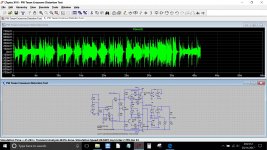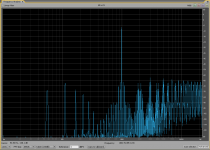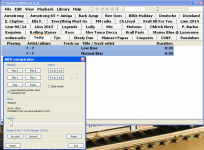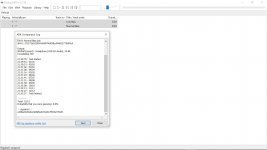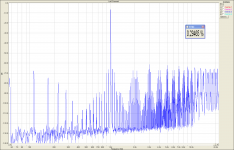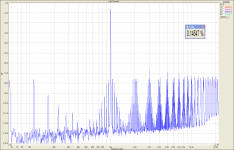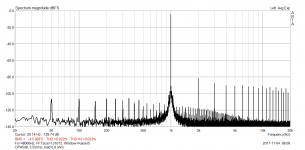OK Mark, but have you tried to identify the original and the re-recorded files? You should be able to hear the DacMagic sound.
FWIW, I did test of original vs re-recorded thru an M-Audio Fast Track Pro. The interconnect loop was made of potatoes, bananas, mud and various other things. The only tell was an elevated noise floor, which not many people picked out.
FWIW, I did test of original vs re-recorded thru an M-Audio Fast Track Pro. The interconnect loop was made of potatoes, bananas, mud and various other things. The only tell was an elevated noise floor, which not many people picked out.
😀
The DacMagic Plus has much less 'sound' than the A/D soundcard. And most of the 'sound' has the speaker loaded chipamp. Still, it seems to be inaudible in abx.
The DacMagic Plus has much less 'sound' than the A/D soundcard. And most of the 'sound' has the speaker loaded chipamp. Still, it seems to be inaudible in abx.
I listened on the DAW computer. It sounds like cc has slightly more HF distortion than oo (in the frequency range I can still hear). But, it is slight and probably easy to loose track of in repeated listening as ear fatigue sets in.
May I ask why we are working at 16/44? Hi-res should be more revealing, especially if we started with a very clean, very low distortion, source file.
iPod made the death of sound quality (2001). Since that time, we live in loudnesswars era. Thank you, Steve! (Btw we both were born 1955)
I can easily make a test tone that has the same amount of crossover distortion measured in these files. It's not hard to hear - but music masks so much.May I ask why we are working at 16/44? Hi-res should be more revealing, especially if we started with a very clean, very low distortion, source file.
- but music masks so much.
Yes, and I suspect it depends on the particular music and recording quality. It also probably helps a lot to hear clearly well above 10kHz too, at least that's my recollection from years back.
Yes, that's masking. I was doing math generated distortion before, but wanted the real thing now.
Most sensitive are pure sine tones and 1/3 octave noise. The music is worst for testing sensitivity, though audiophiles do not realize this fact.
Most sensitive are pure sine tones and 1/3 octave noise. The music is worst for testing sensitivity, though audiophiles do not realize this fact.
I can easily make a test tone that has the same amount of crossover distortion measured in these files.
Pano, you would have troubles to make frequency dependent non-linear distortion that is in this thread. That's why I prefer the real thing. You can quite successfully make 1 tone with 1 amplitude and 1 frequency. But it would be difficult to simulate frequency dependent crossover distorted transfer function.
With a fixed test frequency, cross over distortion should make a buzz harmonically related to the the test tone frequency.
With real music, zero crossings are dependent on many factors and tend to be irregularly spaced in time. So, maybe no buzz, depending on the music.
With real music, zero crossings are dependent on many factors and tend to be irregularly spaced in time. So, maybe no buzz, depending on the music.
Try these Mark. I'm just playing at the moment with an idea so all is not quite as it might appear. Practical Wireless Texan at high and low bias. Pure tone with a 5 second fade in and out.
Everyone should get 100% Foobar result on this. The big question is whether this would be audible on music... that's one for another day though, and it would probably have to be with more subtle bias reduction.
Crossover Distortion
Everyone should get 100% Foobar result on this. The big question is whether this would be audible on music... that's one for another day though, and it would probably have to be with more subtle bias reduction.
Crossover Distortion
Texan (I had it) was worse than this OPA549 amplifier in this test. Would you be able to record a low-noise D/A => Texan => A/D music test file with your setup, Karl? This might be interesting. Low noise and low hum is a key factor.
Lol, yes, I seem to remember it wasn't all that stellar in performance and I imagine a lot worse than the OPA chip. I always fancied having a go at the Texan but had to settle for a germanium kit amp instead 🙂 Happy days.
OK, so the cat is out of the bag already on this one. This is what I am playing with (but why not). The track being recorded this instant is Pavels 'cc' mixed down to mono.
(It will be tomorrow before I get chance to re-run the music file with a low bias and see how it sounds)
OK, so the cat is out of the bag already on this one. This is what I am playing with (but why not). The track being recorded this instant is Pavels 'cc' mixed down to mono.
(It will be tomorrow before I get chance to re-run the music file with a low bias and see how it sounds)
Attachments
Try these Mark. I'm just playing at the moment with an idea so all is not quite as it might appear. Practical Wireless Texan at high and low bias. Pure tone with a 5 second fade in and out.
Everyone should get 100% Foobar result on this. The big question is whether this would be audible on music... that's one for another day though, and it would probably have to be with more subtle bias reduction.
Crossover Distortion
I did Karl 😀. It is too horrible 😉. Just good to show if one can work with foobar. Really, this is too much distorted, especially the mains frequency intermodulations (how did you do it?). Please see my abx and spectrum analysis. This WILL be audible with music.
Attachments
This is very easy to discern to me.Try these Mark. I'm just playing at the moment with an idea so all is not quite as it might appear. Practical Wireless Texan at high and low bias. Pure tone with a 5 second fade in and out.
Everyone should get 100% Foobar result on this. The big question is whether this would be audible on music... that's one for another day though, and it would probably have to be with more subtle bias reduction.
Crossover Distortion
Can you tell the THD?
Attachments
This is very easy to discern to me.
Can you tell the THD?
I can. 0.14% and 0.29%. The problem is not the number, but the content of mains lines and intermodulations. This is far away from the amp we tested here.
Edit: I built the Texan in 1976 or so and had an impression it was the worst amplifier I ever heard. Now I can see that I was right. Those were the SS amps of the seventies, at least some of them.
Attachments
Last edited:
I need to work out how I can try this. Problem is that computer listening can only really be done at work. I am really intrigued by this one.
Karl, for comparison purposes, I am posting a 1kHz file recorded through OP549 amp under test, Vout = 3.5Vrms and Rload = 6.8 ohm. This is close to conditions during my test recording.
http://pmacura.cz/1khz_549.zip
measurement attached, THD = 0.022%, this is about 10x less than Texan, but note that mains spectral lines lie more than 100dB below the 1kHz and there are no mains intermodulations. This is a big difference and this is what makes the difference in audibility, not only the THD number itself. Your amp makes too much buzz and intermodulations, so it is not only crossover distortion tested, but rather all other issues. Despite that said, the test with music might be interesting with your Texan.
http://pmacura.cz/1khz_549.zip
measurement attached, THD = 0.022%, this is about 10x less than Texan, but note that mains spectral lines lie more than 100dB below the 1kHz and there are no mains intermodulations. This is a big difference and this is what makes the difference in audibility, not only the THD number itself. Your amp makes too much buzz and intermodulations, so it is not only crossover distortion tested, but rather all other issues. Despite that said, the test with music might be interesting with your Texan.
Attachments
I did Karl 😀. It is too horrible 😉. Just good to show if one can work with foobar. Really, this is too much distorted, especially the mains frequency intermodulations (how did you do it?). Please see my abx and spectrum analysis. This WILL be audible with music.
That's a good question. I didn't do anything 😀 That was the result of the simulation. As far as I know this is all pure calculation by the PC, the adio stages and sound card do not play a part. So there should be no outside influence.
That theory needs testing out then... one for later.
I can. 0.14% and 0.29%. The problem is not the number, but the content of mains lines and intermodulations. This is far away from the amp we tested here.
Edit: I built the Texan in 1976 or so and had an impression it was the worst amplifier I ever heard. Now I can see that I was right. Those were the SS amps of the seventies, at least some of them.
Does the Texan add its own bit of magic to the music 🙂
I haven't given these files a serious listen but will post for interest. The Mono Mix is Pavels test track mixed down to mono and fed into the simulation twice, once for normal bias and once for low bias. All three tracks were level adjusted to -3db peak in Audacity.
Texan Music
That's a good question. I didn't do anything 😀 That was the result of the simulation. As far as I know this is all pure calculation by the PC, the adio stages and sound card do not play a part. So there should be no outside influence.
Wow!!!!!!!!!!!!! I did not get it before 😀😀
I am going to test your files.
- Status
- Not open for further replies.
- Home
- General Interest
- Everything Else
- Test your ears in my new ABX test
